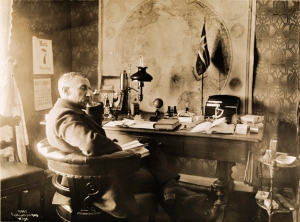Science and recordsToday we passed the latitude of Shackleton’s farthest south record from January 1909. It would have been an excellent reason to stop and reflect, but today we have only two things on our minds: 14 December and the incredibly gritty snow. Pulling a sled here – just as we have quoted Amundsen as saying – is truly reminiscent of a sledding trip through the Sahara. Thirteen hours on skis and all we have to show for it is 30 more kilometres in our log-book.
“Fine weather again. Light SSE’ly breeze and −28°. Sometimes quite clear. Sometimes a passing patch of mist. A lovely big ring round the sun. ”– Amundsen on this day 100 years ago (Read more …) 
When Shackleton returned from 88 degrees 23 minutes south, no-one had any reason to wonder what the pole itself would look like. More of the same: snow and ice. From this perspective one might aver that there was little scientific value in coming to the mathematically precise southernmost point on the globe a scant three years later. So what was Amundsen’s expedition actually worth? That’s a question we have discussed frequently during this trip. Amundsen himself wrote that the primary goal was to be first to the pole: “On this little deviation, science took care of itself.” And Sverre Hassel admitted: “If we weren’t the first to the South Pole, we might just as well have stayed at home.” Fridtjof Nansen, on the other hand, took a broader view when he commented on Amundsen’s expedition. He considered it “a research trail into the heart of the unknown.” Weather and wind ensured that the actual trail was soon swept away: “but a scientific trail has been blazed and our knowledge has been enriched.” Is there necessarily any contradiction between records and research? That’s another thing we have talked about along the way. No-one set more polar records that Amundsen, but at the same time, his expeditions provided important knowledge about our planet. One might say that Amundsen’s expeditions sailed to sea with a cargo of scientific questions and came home with observations that contributed strongly to the development of geophysics in Norway. As we struggle onwards across the abrasive snow following Amundsen’s long-gone tracks, our thoughts go to two interesting current events in Tromsø – a seminar on Amundsen at the University of Tromsø, and a play called Amundsen vs Nansen at the Hålogaland Theatre. Each highlights in its own way the relationship between science and records in polar regions. If you speak Norwegian and are anywhere near Tromsø, don’t miss either event! Position: S 88 33.382, E 179 40.289
Temperature: -36°C Wind: Calm Elevation: 3120 metres Distance traversed: 30 km Distance behind Amundsen: 29 km Total distance traversed: 1150 km Distance remaining to the South Pole: 161 km Did you know that many countries have research stations in Antarctica?
Antarctica is a continent with no permanent residents, but many researchers stay for short or long periods at one of the 75 research stations that have been established in Antarctica. |
South Pole 1911–2011 is an informational outreach project run by the Norwegian Polar Institute
Contact person:


